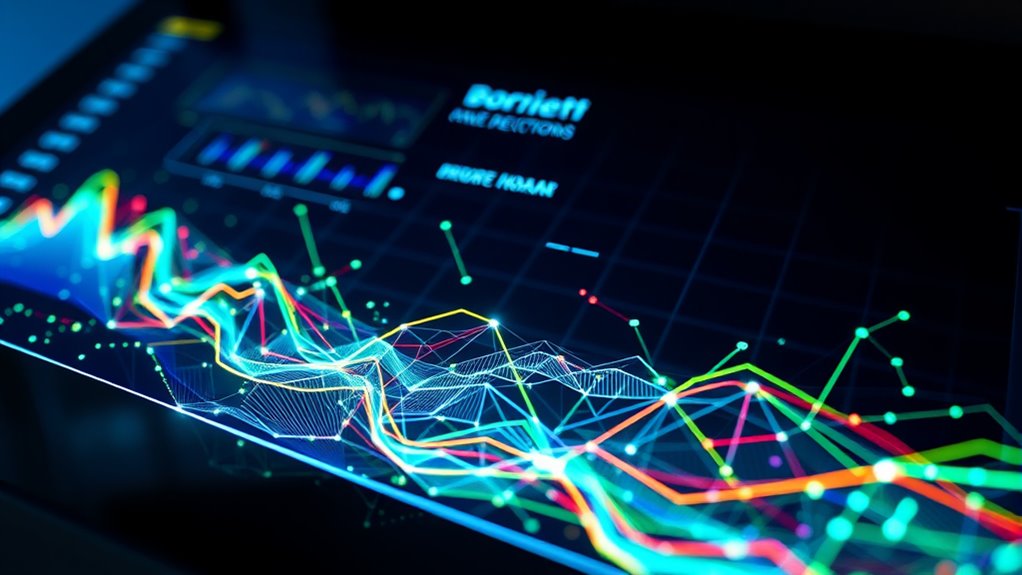AI predicts patterns by analyzing large volumes of data to find recurring trends and subtle connections that you might not notice. Machine learning algorithms learn from this data, improving their accuracy over time as they identify complex behaviors. They process both structured and unstructured information to forecast outcomes, allowing for smarter decisions. The more data they analyze, the better their predictions become. Keep exploring, and you’ll discover how this technology transforms industries and decision-making processes.
Key Takeaways
- AI uses machine learning algorithms to analyze large datasets and identify recurring patterns or trends.
- Continuous data feeding allows models to adapt and improve pattern recognition over time.
- Pattern detection involves training models to recognize subtle or complex signals within unstructured data.
- Real-time data processing enables AI to update predictions dynamically as new information becomes available.
- Effective pattern prediction depends on high-quality data and proper preprocessing to ensure accurate model training.

AI pattern predictions are transforming how we anticipate future developments across industries. At the core of this transformation is machine learning, a technology that enables AI systems to recognize complex patterns within vast amounts of data. When you work with AI for pattern prediction, you’re harnessing the power of algorithms that learn from data analysis, constantly improving their accuracy over time. This process involves feeding large datasets into models, which then identify subtle trends or recurring behaviors that might not be immediately obvious to humans. As a result, you can forecast outcomes, optimize processes, and make informed decisions with greater confidence.
AI pattern predictions enable smarter decision-making by uncovering hidden trends in large data sets.
In practical terms, machine learning algorithms sift through enormous datasets, searching for correlations and patterns that can indicate future events. For example, in finance, AI models analyze market data to predict stock price movements or economic shifts. In healthcare, they scrutinize patient records to forecast disease outbreaks or treatment outcomes. The key is that these models don’t just memorize data — they learn underlying structures, enabling them to generalize predictions to new, unseen data. This ability to analyze data efficiently and extract meaningful insights gives you a competitive edge, whether you’re managing supply chains, designing marketing strategies, or developing new products.
Data analysis plays a vital role in this process. It involves cleaning, structuring, and examining raw data to uncover hidden insights. AI uses sophisticated techniques to process unstructured data—like images, text, or sensor readings—and convert it into valuable information. Once the data is prepared, machine learning models are trained on it, allowing you to detect patterns that inform future predictions. This ongoing cycle of data collection, analysis, and model refinement helps AI systems adapt to changing conditions, making their predictions more accurate over time. When you implement these tools, you gain the ability to anticipate customer needs, identify potential risks, and allocate resources more effectively.
Furthermore, AI pattern predictions aren’t static; they evolve as more data becomes available. You can continuously feed new information into models, which refine their understanding and improve forecasting accuracy. This dynamic learning process means you’re not just relying on historical data but also on real-time insights. It empowers you to respond swiftly to emerging trends and make proactive decisions rather than reactive ones. Overall, by leveraging machine learning and data analysis, AI enables you to anticipate future developments with a level of precision and speed that was unimaginable just a few years ago. This transformative capability is reshaping industries and redefining how we approach decision-making in a data-driven world. Recognizing the importance of data quality and preprocessing is essential to maximizing the effectiveness of AI predictions.
Frequently Asked Questions
How Accurate Are AI Pattern Predictions Across Different Industries?
AI pattern predictions are quite accurate across industries, but their reliability depends on the algorithm’s adaptability and the quality of data. If the algorithm adapts well to new patterns, predictions improve. However, data bias can skew results, leading to less precise outcomes. You should regularly update and validate data, and choose adaptable algorithms to maximize prediction accuracy across different sectors.
Can AI Predict Unexpected or Rare Pattern Changes?
AI can sometimes predict rare event changes, but it’s like finding a needle in a haystack. By using anomaly detection, AI spots unexpected pattern shifts and rare events, yet it’s not perfect. Unexpected changes can be so unique they slip through the cracks. While AI’s getting better, you still need human intuition to catch those truly surprising anomalies and make certain nothing major slips by unnoticed.
What Are the Limitations of AI in Pattern Recognition?
You should know that AI faces limitations in pattern recognition due to bias issues and data dependence. Bias issues can skew results, making AI overlook certain patterns or favor others unfairly. Data dependence means AI relies heavily on the quality and quantity of training data, so if the data is incomplete or biased, the AI’s pattern recognition becomes less accurate. These limitations can hinder AI’s ability to identify complex or subtle patterns reliably.
How Does AI Handle Noisy or Incomplete Data?
When you feed noisy or incomplete data into AI, it’s like trying to listen through static. You handle this by performing data preprocessing and noise filtering, which cleans up the mess and reveals the hidden signals. These steps help AI focus on the true patterns beneath the chaos, making predictions more accurate. Think of it as tuning a radio to catch the clearest signal, even amid the noise.
What Ethical Concerns Arise With AI Pattern Predictions?
You should be aware that ethical concerns with AI pattern predictions include bias mitigation challenges and transparency issues. Bias can lead to unfair decisions, impacting marginalized groups, while transparency problems make it hard to understand how AI arrives at certain predictions. This can erode trust and make accountability difficult. To address these concerns, developers must prioritize fair algorithms and clear explanations, ensuring AI systems act ethically and responsibly.
Conclusion
So, by mastering AI’s pattern predictions, you hold the power to foresee the future itself. Imagine a world where every trend, every choice, is laid bare before your eyes—like having a crystal ball in your hands. But remember, with great prediction comes even greater responsibility. Use this power wisely, because if you can see the patterns, you can also shape the future—making you the ultimate architect of tomorrow’s reality.








